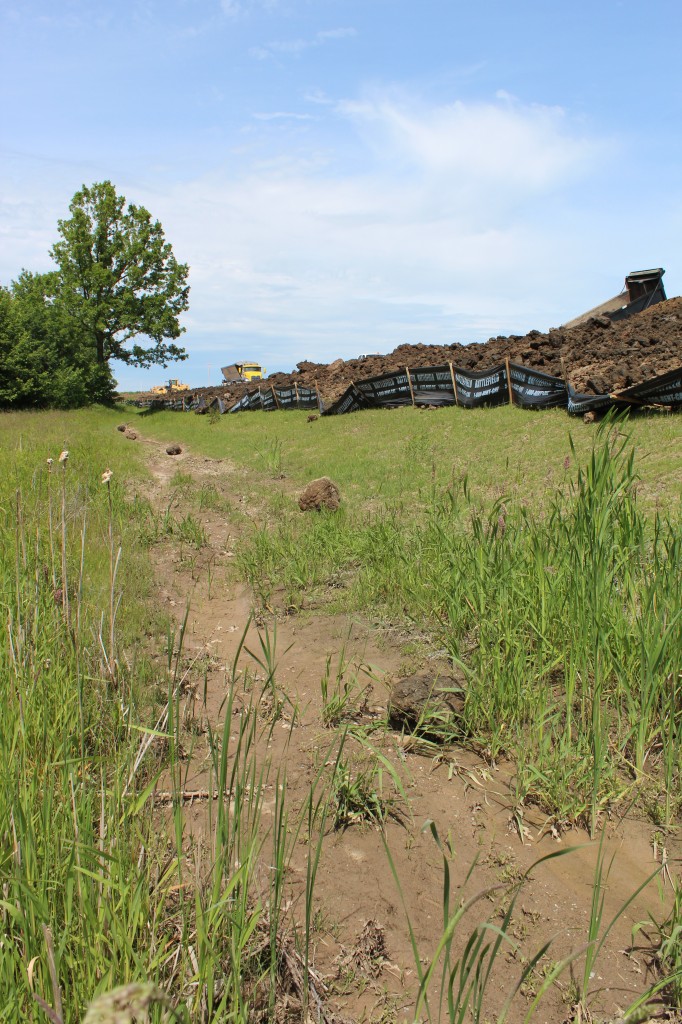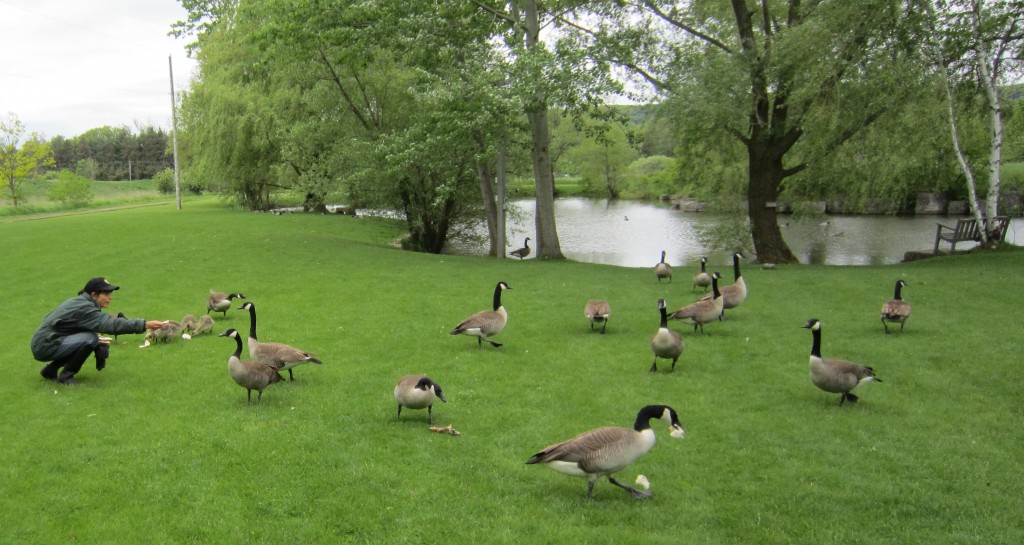BURLINGTON, ON. June 10, 2013. It`s a grind. There are so many levels of jurisdiction that it gets difficult to figure out who is responsible for what, but the city of Burlington is on the case and they are ferreting out information at a pace that is indeed remarkable for a municipal administration. Kudo`s to them for that.
Now to figure out what they have gathered in the way of information and what potential action there is for the city to take.
The city got into this when city council heard complaints about landfill operations that were taking place at the Burlington Executive Air Park. The work has been taking place since around 2008 but no one seems to have taken their complaints to the city until Dr. Teri Jaklin wrote a letter to the Council member for Ward 6, Blair Lancaster, who didn`t do much for the Dr. Jaklin wither response. Barbara Sheldon, the Appleby Line resident who has suffered the most damage, then wrote Lancaster a scathing letter
When Vanessa Warren created the Rural Burlington Greenbelt Coalition and made a delegation to city hall the wheels started moving. Up until that point no one had been on Barbara Sheldon`s property to see the amount of landfill that had been dumped. Lancaster has yet to see the property. Councillors Meed Ward, Taylor and Sharman have visited as has the Mayor who was appalled at what he saw.

The is the view of the south side of the Sheldon property on Appleby Line. Trucks were dumping the day the pictures were taken.
Sheldon is a major piece of business: direct, no-nonsense, no crap – do not speak to this lady with a forked tongue. Not a woman to be trifled with. The only relief she has had is a small reduction in her tax assessment – which at least has one government organization saying something has been done to change the value of this property.
On May 21st City Council issued a Staff Direction to the General Manager of Development & Infrastructure to contract with an aviation consultant to report on: The standards, processes and requirements of Transport Canada and other Federal departments for the development and expansion of aeronautical facilities; and to identify any opportunities for individual, municipal or provincial involvement and input in said Federal processes, and to expedite the presentation of recommendations to address the immediate issues of land fill, noise and expansion at the Burlington Airpark. Those were the marching orders.
So – what do we know?
A lot of information has been gathered and in the report General Manager of Development and Infrastructure Scott Stewart will make to Council this evening we learn of what has been done and what has not been done.
To put it mildly – Stewart didn’t manage to pull many teeth from a hen.
Information is being made available to the city by people who represent Vince Rossi, owner of the airport. Meetings have taken place between the City and Airport representatives (Mr. Milt Farrow and Mr. Tim Crawford) to facilitate a cooperative approach to addressing the City’s request for information regarding the past and current filling operations at the Airport site. Information is being delivered in dribs and drabs but at least there is some movement.
During all this jabber, jabber the airport people maintain that their operation – the Burlington Executive Air Park, comes under federal Department of Transport jurisdiction and so the city can just take a hike, legally.
We have been seeking an interview with airport owner Vince Rossi – he used to email us – we don’t hear from him anymore. He has learned what media people now call the “Rob Ford approach” – say nothing no matter how bad it looks. Stonewall, obfuscate, put out platitudes but don’t say anything direct. Send others to represent your interests; helps if one of them is a lawyer.
Rossi’s people did communicate with the city through the office of Councillor Lancaster, who many in the community feel is far too close to the airport owners. The email, sent to city staff May 27, 2013 by Councillor Lancaster advised that the airpark informed her that the city would receive a letter with soil test samples and they will work with the City on the esthetics of the berm. To date a letter has not been received.
Councillor Lancaster would be well advised to direct the airport owners to communicate directly with the city.

While all the jabber, jabber goes on Barbara Sheldon watches as the pile of landfill on the north and south side of her home gets higher and higher. More than 32 feet on the north side and no one knows how much higher on the south because they are still dumping.
The city wants data on past and current filling operations at the site. They have also requested a grading and drainage plan, current and past soil test reports, the continued maintenance of silt fencing around the work area, securities to ensure contractor performance and permission for City staff to access the site.
The city argues this information would be required for review by City staff to reach a conclusion that a site alteration permit could be issued if one was applied for. Rossi and his people have taken the position that they don’t need permission from the city – they are federally regulated.
King Paving, the company that is hauling in the bulk of the landfill these days, has the majority of the original soil reports. Milt Farrow followed up with King to organize the reports and to have them photocopied. The first batch of the photocopying of the reports was not completed until May 31st. Mr. Farrow delivered 5 reports to the City on May 31, 2013 at 4:15 pm. An additional 15 reports were delivered on June 5, 2013 at 1:30 pm.
The city points out that soil test reports undertaken years prior are unacceptable because the City has no knowledge of what has occurred on the source site since the tests were undertaken.
There is not a lot of trust between the city and the air park operators.
Whenever changes are made to property a process called Environmental Assessments come into play. There are phase 1 assessments and phase 2 assessments; it’s all kind of arcane and difficult for parents who want to get the kids to soccer on time, but a process fully understood by planners and lawyers who know how to exploit these processes to the fullest.
Milt Farrow advised the City that last year, as part of a potential financing arrangement, the Toronto Dominion bank was provided with additional soil test reports and a Phase 2 Environmental Site Assessment (ESA).
The air park position is that the city has no jurisdiction and is not entitled to stick their noses in and ask for data and Environmental Assessments but if you want financing from the bank – guess what – the required documents appear.
In the criminal world investigators always tell you to “follow the money”. In times past it was “follow the babe” but times have changed.
Mr. Farrow has apparently agreed to try and get the soil reports back from the bank and provide them to the City. He would also ask Mr. Vince Rossi (Airport Owner) for permission to provide the Phase 2 ESA.
Clearly a pressure point is at the bank level. Drag them into this and let them feel the ire of the community. Banks just can’t loan money with no concern as to what the funds are going to be used for and what good or harm they will do to the community. The days of loaning money and getting the best return are over – there is now a social responsibility element to all this. Being socially responsible is also good business. For all of those who live in north Burlington and have accounts with the TD Bank – mention your concern to your branch manager and write the head office.
A “DRAFT” Phase 1 Environmental Site Assessment (ESA) was provided by Rossi yesterday to city hall as opposed to the Phase 2 ESA previously discussed. A formal request for the Phase 2 ESA report has been made by the city. If this were a typical Site Alteration Permit process, the City would not be in a position to issue a permit because the typically required information has not all been provided.
Rossi and his representatives argue they are federally regulated. Well are they?
Transport Canada is being co-operative. The city was in contact with them May 14, before the Williams delegation was made, to pose some basic questions regarding jurisdiction over the fill operations at the airpark and the approval process should the airpark expand.
On the issue of fill, the city was advised that there were no specific rules or legislation pertaining to fill, but made it clear that anything integral to aviation was under federal jurisdiction. Transport Canada indicated that importing fill to an aerodrome to build aeronautics facilities would be subject to federal jurisdiction. However, they Transport people, also indicated that fill could be subject to other authorities (local, provincial, conservation authority), citing specifically the ability to regulate the quality of fill. Transport advised that fill could fall within federal jurisdiction if it pertained to aeronautics, giving the example that if fill contained magnetic material, Transport Canada would have an interest as this could impair aeronautics.
Transport Canada, advised that on the matter of expansion and approvals required there are different rules for the different types of operations. Burlington Airpark is a registered aerodrome, and that there is a distinction between registered and certified aerodromes.
Registered aerodromes are registered with Transport Canada, which publishes the Canada Flight Supplement. Aerodromes are required to comply with Part 301 of the Canadian Aviation Regulations. Transport Canada does not typically inspect these facilities, unless there is a need to do so. In terms of expanding or modifying the airpark, Transport Canada advised that there is no process that the owner would have to follow, except to notify Transport Canada and change the published information in the flight supplement.
Gets complex. People who want to make changes that others don’t want exploit these complexities and get away with it. Something one wants to know and never forget – don’t mess with city hall. They have long arms and even longer memories.
Certified aerodromes must comply with document TP-312 – Aerodrome Standards and Recommended Practices. Transport Canada requires an aerodrome to become certified under the following circumstances: . Aerodrome has regular passenger service; Aerodrome is within a “built up area” – no hard rules on this, but opinion is usually there is “built up area” on 3 sides minimum. Deemed to be necessary in the public interest by the Minister.
Burlington Airpark used to be certified. It is believed the certification was removed around the time the airpark was sold in 2006-07.
This exchange of information led the city to asking: Is there a functional or regulatory difference between “airport” and “aerodrome” as defined by Transport Canada? The city also wanted to know if calling themselves the “Burlington Executive Airport” signifies anything from a legislative or regulatory perspective.
The city also wants to know if there is anything in the Transport Canada rules that outlines Transport Canada’s position with respect to the City’s ability to enforce its own by-laws?






















The airport is not only affecting the lives of the residents along Appleby Line, but also those living on No. 2 and No.4 Sideroads. We have all complained to the city, and the Ward 6 council reps, past and present, without any results. Ms Lancaster used the corn roasts for pure publicity among residents south of Dundas as she announced the roasts at the airport at meetings to her constituents in that area, but never advised those actually affected by the airport. I am not stating anything here that I have not told her myself. I am certain that the City, Region, and Halton Conservation can do more than they have done so far, but the will to do so appears to be lacking.
I just watched the video of last nite’s Council meeting, in which Barbara Sheldon (again and accurately) nailed Councilor Lancaster for her obvious loyalty to the Airpark owner and not to the Constituents who actually live in her Ward.
Ward 6 DEFINITELY needs a new Councilor.